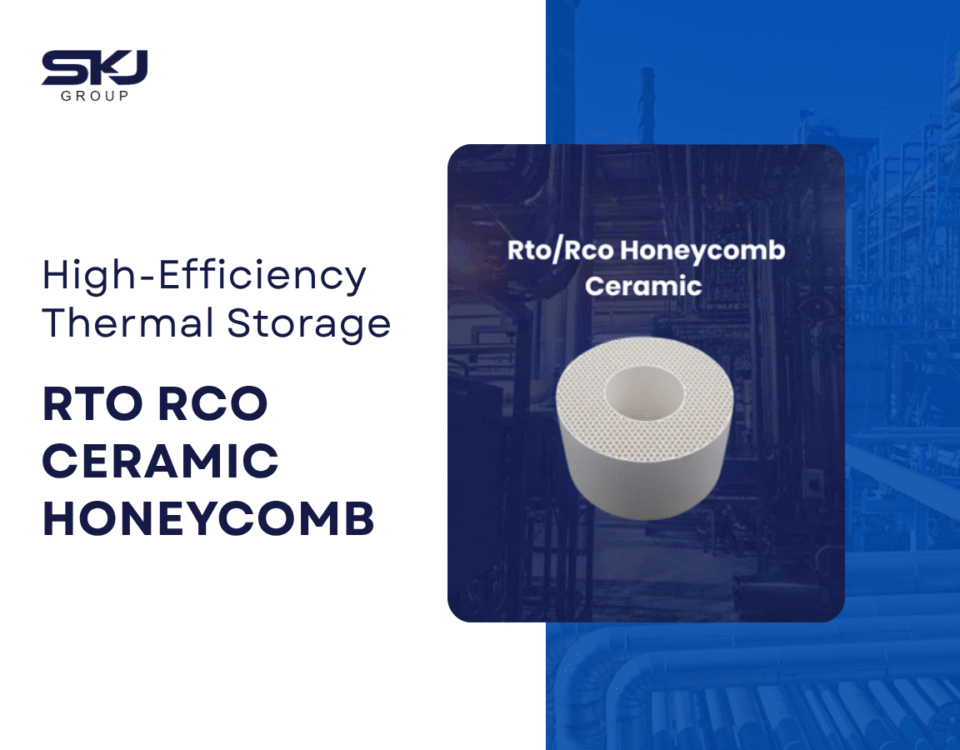Why Are Ceramic Honeycombs Essential for Air Pollution Control?

How Do Ceramic Grid Blocks Improve Heat Distribution in Furnaces?
July 16, 2025
When should you use inert ceramic balls instead of metal catalysts?
August 4, 2025Air pollution is one of the most urgent industrial challenges of our time. From power plants to petrochemical refineries, reducing toxic emissions is no longer a choice—it’s a compliance mandate. Enter ceramic honeycombs—compact, highly porous structures that have revolutionized emission control systems.
In this blog, we’ll explore why ceramic honeycombs are essential for air pollution control, especially in Indian industries. We’ll break down how they work, where they’re used, and why choosing the right ceramic honeycomb supplier or honeycomb manufacturer matters more than ever.
What Are Ceramic Honeycombs?
Ceramic honeycombs are structured ceramic blocks with hundreds of parallel channels that form a honeycomb-like shape. Their primary role is to filter, absorb, or catalyze harmful gases during industrial operations.
Common features include:
- High surface area
- Excellent thermal stability
- Acid and alkali resistance
- Low pressure drop across the structure
How Ceramic Honeycombs Work in Air Pollution Control
1. Catalytic Converters in RTOs and Scrubbers
Ceramic honeycombs are widely used in Regenerative Thermal Oxidizers (RTOs) and catalytic converters to convert harmful gases like NOx, CO, and VOCs into harmless gases such as CO₂ and water vapor.
Benefit: They enable high conversion efficiency with minimal energy input.
2. Adsorption and Filtration of Particulate Matter
Thanks to their porous walls, ceramic honeycombs trap:
- Soot particles
- Heavy metal vapors
- Acidic aerosols
They’re particularly valuable in industries where fine particulate emissions are a concern, such as cement plants, steel manufacturing, and incineration units.
3. Heat Exchange in Exhaust Streams
In waste heat recovery systems, ceramic honeycombs act as thermal reservoirs, preheating clean incoming air using the hot exhaust gases. This:
- Boosts energy efficiency
- Reduces fuel costs
- Minimizes CO₂ emissions
Why Are Ceramic Honeycombs Becoming Essential?
1. Regulatory Push for Cleaner Emissions
As environmental norms tighten in India and globally, industries are investing in advanced air pollution control technologies. Ceramic honeycomb exporters are witnessing growing demand due to their compliance with:
- CPCB standards (India)
- EPA norms (USA)
- Euro VI emission limits (Europe)
2. Long-Term Cost Savings
Although initial installation may be costly, ceramic honeycombs:
- Require less maintenance
- Offer long operational life
- Reduce energy and chemical usage in emission systems
The return on investment (ROI) is higher compared to traditional media like glass fiber or metal mesh filters.
3. Lightweight and Compact Design
Unlike bulky scrubber tanks or metal grids, ceramic honeycombs are:
- Easy to install
- Space-saving
- Modular (can be stacked or customized)
Perfect for retrofit projects in old industrial setups.
Where Are Ceramic Honeycombs Used in India?
| Industry | Application |
| Automotive | Catalytic converters |
| Petrochemical | NOx & VOC reduction systems |
| Waste Incineration | Flue gas treatment |
| Thermal Power Plants | Emission filtration & heat recovery |
| Cement Manufacturing | Dust and fume control |
How to Choose the Right Ceramic Honeycomb Supplier?
Material Quality
Opt for cordierite or alumina-based ceramics for superior thermal and chemical resistance.
Precision in Design
A good honeycomb manufacturer offers precise cell density (CPSI), wall thickness, and size specifications.
Testing and Standards
Ask about thermal shock resistance, compressive strength, and porosity test reports.
Export Capability
If you’re sourcing internationally, choose ceramic honeycomb exporters with proven global logistics and support.
Benefits at a Glance
- High thermal stability
- Efficient gas conversion
- Long operational life
- Lower energy consumption
- Adaptable to various industries
FAQ Section
Q1: How often do ceramic honeycombs need replacement?
A: Typically after 3–5 years, depending on the operating environment.
Q2: Can they withstand corrosive gases?
A: Yes, they resist acids, alkalis, and high temperatures effectively.
Q3: Are they eco-friendly?
A: Yes. They help industries meet emission norms and reduce carbon footprints.
Q4: Can I use them in existing RTO systems?
A: Most suppliers offer custom dimensions for retrofitting existing systems.
Conclusion
From improving emission standards to enhancing operational efficiency, ceramic honeycombs are now an industrial must-have. Whether you’re managing a power plant, refinery, or chemical processing unit, these structured ceramics offer a cleaner, smarter, and more sustainable way to handle air pollutants.
Ready to upgrade your emission control system?
Partner with India’s leading ceramic honeycomb supplier and stay ahead of the regulatory curve.




